The Soda Maker Market is estimated to be valued at USD 1.1 billion in 2025 and is projected to reach USD 2.2 billion by 2035, registering a compound annual growth rate (CAGR) of 7.5% over the forecast period. The soda maker market is projected to deliver an absolute gain of USD 1.1 billion and a growth multiplier of 2x over the decade. This growth, driven by a CAGR of 7.5%, is fueled by rising consumer interest in home carbonation devices, increasing demand for healthier beverage alternatives, and the growing trend of personalization in food and drink preparation.
During the first five years (2025–2030), the market will grow from USD 1.1 billion to USD 1.6 billion, adding USD 0.5 billion, accounting for 45.5% of the total incremental growth, with a 5-year multiplier of 1.45x. The second phase (2030–2035) contributes USD 0.6 billion, representing 54.5% of the total growth, driven by broader adoption in both developed and emerging markets, enhanced product features, and innovations in carbonation technology.
Annual increments rise from USD 0.1 billion in early years to USD 0.3 billion by 2035, signaling stronger growth driven by product diversification, lower prices, and more accessible distribution channels. Manufacturers focusing on energy efficiency, user experience, and health-conscious product offerings will capture the largest share of this USD 1.1 billion opportunity.
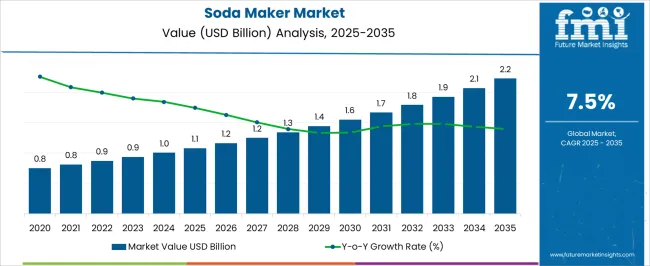
| Metric | Value |
|---|---|
| Soda Maker Market Estimated Value in (2025 E) | USD 1.1 billion |
| Soda Maker Market Forecast Value in (2035 F) | USD 2.2 billion |
| Forecast CAGR (2025 to 2035) | 7.5% |
The soda maker market is witnessing substantial growth as consumers increasingly shift toward healthier and cost-effective alternatives to packaged soft drinks. The current market scenario reflects rising demand for home carbonation systems that allow users to control sugar levels, flavors, and carbonation strength.
This demand is further supported by growing awareness around sustainability, as soda makers help reduce plastic waste associated with bottled beverages. The market outlook remains positive with continued innovation in user-friendly designs, flavor infusion technologies, and compact appliances suited for modern kitchens.
As consumers across both developed and emerging economies become more conscious of ingredient transparency and beverage customization, soda makers are gaining traction not only in residential settings but also in small-scale commercial environments. In the coming years, product upgrades combined with increased retail visibility are expected to pave the way for continued expansion and higher adoption rates globally.
The soda maker market is segmented by operation, distribution channel, and geographic regions. By operation, the soda maker market is divided into Manual and Electric. In terms of distribution channel, the soda maker market is classified into Offline and Online. Regionally, the soda maker industry is classified into North America, Latin America, Western Europe, Eastern Europe, Balkan & Baltic Countries, Russia & Belarus, Central Asia, East Asia, South Asia & Pacific, and the Middle East & Africa.
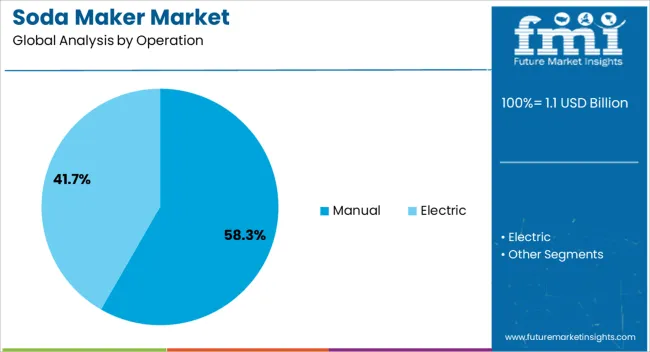
The manual operation segment is projected to account for 58.3% of the Soda Maker market revenue in 2025, making it the most dominant operational type. This significant share is being attributed to the simplicity, affordability, and user control offered by manual soda makers. Consumers have shown a strong preference for devices that do not rely on electricity or batteries, allowing more flexibility in use across different settings, including homes, outdoor spaces, and travel.
The manual category has also gained popularity due to its minimal maintenance requirements and lower initial investment compared to electric models. As price sensitivity continues to influence purchase decisions, especially in emerging markets, the manual segment remains a favored choice.
Additionally, manufacturers have responded by introducing sleek and aesthetically pleasing manual models that align with modern kitchen décor, further contributing to their strong market position. The growing interest in do-it-yourself beverage preparation continues to support the sustained dominance of manual soda makers across key regional markets.
The offline distribution channel is anticipated to contribute 64.7% of the Soda Maker market revenue in 2025, positioning it as the leading sales channel. This dominance is being driven by strong consumer reliance on physical retail formats such as appliance stores, department stores, and specialty kitchen outlets. In-store demonstrations, hands-on product trials, and immediate product availability have reinforced consumer confidence in offline purchases, particularly for first-time buyers seeking tangible evaluation before investment.
The offline segment has also benefited from widespread retail penetration in urban areas where lifestyle appliance sales are concentrated. Additionally, the presence of trained staff offering usage guidance and after-sales support has further strengthened customer trust and purchase decisions.
Promotions, bundle offers, and seasonal discounts available through offline retail have helped maintain steady footfall and conversion rates. As the soda maker category becomes more mainstream, its visibility in offline retail environments remains a critical factor supporting continued revenue leadership in this distribution segment.
The soda maker market is driven by increasing demand for home carbonation solutions and opportunities in the expanding beverage and health-conscious segments. Emerging trends in smart soda makers with enhanced features are reshaping the market, while challenges like high initial costs and limited awareness remain obstacles. By 2025, overcoming these challenges through cost-effective solutions and better consumer education will be key to continued growth and wider adoption.
The soda maker market is growing due to the rising demand for home beverage carbonation solutions. Consumers are increasingly looking for convenient and cost-effective ways to create carbonated drinks at home. Soda makers offer a customizable and eco-friendly alternative to store-bought sodas, which can be expensive and wasteful. By 2025, the market will continue to expand, driven by consumers’ preference for personalized, healthier, and more affordable beverage options.
Opportunities in the soda maker market are growing with the expansion of the beverage and health-conscious segments. As consumers seek healthier, low-calorie, or sugar-free alternatives to traditional sodas, soda makers allow for customization of flavors and ingredients. The increasing popularity of flavored sparkling waters and natural beverages is further fueling market growth. By 2025, these opportunities will continue to shape the market, particularly as more consumers focus on controlling what goes into their beverages.
Emerging trends in the soda maker market include the rise of smart soda makers with connectivity features. These devices can be controlled via smartphone apps, offering users more control over carbonation levels and drink flavor customization. Additionally, some smart models allow for automatic mixing and preset drink options, enhancing convenience and user experience. By 2025, these smart soda makers will become a dominant trend, offering more innovative features for tech-savvy consumers.
Despite growth, challenges related to high initial investment and limited consumer awareness persist in the soda maker market. The upfront cost of purchasing a soda maker can be a barrier for some consumers, especially when compared to inexpensive bottled sodas. Additionally, many consumers are still unaware of the benefits or versatility of soda makers. By 2025, overcoming these challenges through education and more affordable pricing strategies will be crucial for broader market penetration.
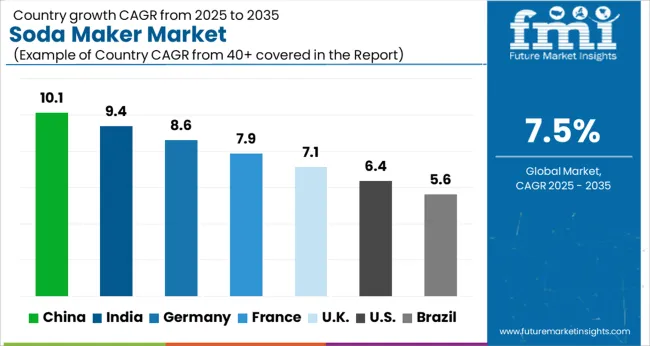
The global soda maker market is projected to grow at a 7.5% CAGR from 2025 to 2035. China leads with a growth rate of 10.1%, followed by India at 9.4%, and Germany at 8.6%. The United Kingdom records a growth rate of 7.1%, while the United States shows the slowest growth at 6.4%. These varying growth rates are driven by factors such as increasing consumer demand for home carbonation solutions, growing health-consciousness, and the desire for customizable beverages. Emerging markets like China and India are experiencing higher growth due to rising disposable incomes, urbanization, and the adoption of modern home appliances, while more mature markets like the USA and the UK see steady growth driven by innovations in product designs, convenience, and sustainability. This report includes insights on 40+ countries; the top markets are shown here for reference.
The soda maker market in China is growing rapidly, with a projected CAGR of 10.1%. The rising consumer demand for home carbonation solutions, driven by the growing interest in healthier and more customizable beverage options, is fueling market growth. China’s expanding middle class, urbanization, and increasing disposable incomes are contributing to the rising adoption of modern kitchen appliances, including soda makers. Additionally, the country’s growing interest in sustainability and eco-friendly products, combined with increasing awareness about reducing sugar consumption, further accelerates the demand for soda makers.
The soda maker market in India is projected to grow at a CAGR of 9.4%. India’s growing urban population, increasing disposable incomes, and rising health-consciousness are driving the demand for home carbonation solutions. The country’s rising preference for convenient, customizable beverage options, coupled with increasing awareness of the health risks of sugary soft drinks, is further contributing to market growth. Additionally, the increasing popularity of eco-friendly and cost-effective home appliances is fueling the adoption of soda makers across households in India.
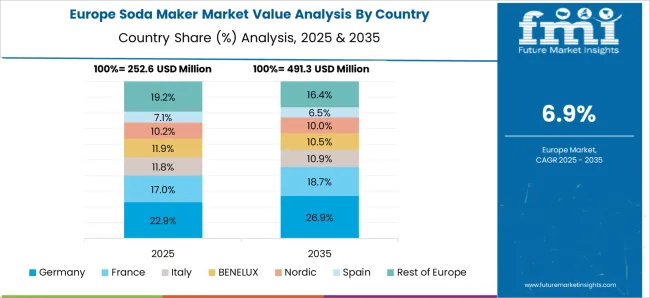
The soda maker market in Germany is projected to grow at a CAGR of 8.6%. Germany’s growing interest in sustainable and health-conscious consumer products is driving the demand for soda makers, particularly in households seeking to reduce sugar intake and carbon footprint. The country’s emphasis on eco-friendly and energy-efficient products, combined with innovations in home appliances, is contributing to market growth. Additionally, Germany’s robust retail infrastructure and rising consumer awareness about the benefits of home carbonation systems further support the growing adoption of soda makers.
The soda maker market in the United Kingdom is projected to grow at a CAGR of 7.1%. The UK’s demand for home carbonation solutions is driven by the growing popularity of health-conscious and customizable beverages. The country’s increasing preference for eco-friendly, sustainable products, along with rising awareness about reducing sugar consumption, further accelerates market growth. Additionally, the UK market benefits from innovations in soda maker designs, ease of use, and the increasing trend of at-home beverage preparation, which contributes to steady adoption.
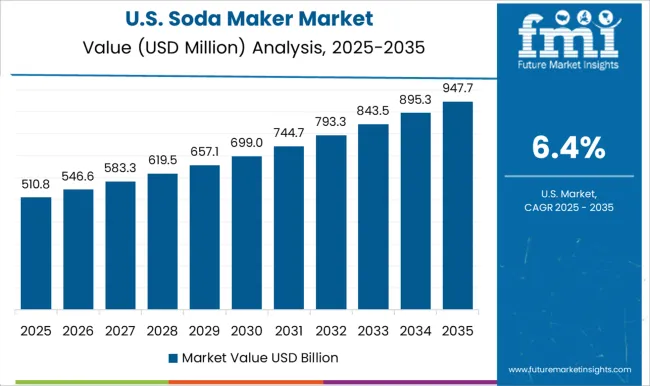
The soda maker market in the United States is expected to grow at a CAGR of 6.4%. The USA market remains steady, driven by the increasing preference for healthy, customizable beverages and home carbonation solutions. The country’s growing health-conscious consumer base, coupled with the rising awareness of the adverse effects of sugary drinks, is contributing to the demand for soda makers. Additionally, the growing trend of sustainability, combined with product innovations and convenience in use, is supporting steady market growth in the USA

The soda maker market is dominated by SodaStream Inc., which leads with its wide range of innovative home soda makers that allow consumers to easily carbonate water and create custom fizzy drinks at home. SodaStream’s dominance is supported by its strong brand recognition, robust distribution network, and commitment to sustainability through its reusable CO2 cylinders and eco-friendly designs. Key players such as AARKE AB, Hamilton Beach Brands Holding Company, and i‑Drink Products Inc maintain significant market shares by offering stylish, user-friendly soda makers that cater to various consumer preferences, from sparkling water enthusiasts to DIY soda makers. These companies focus on improving carbonation performance, ease of use, and product longevity.
Emerging players like Mysoda, Drinkpod, and Spärkel Beverage Systems are expanding their market presence by offering specialized soda makers that cater to niche applications, such as creating low-sugar sodas, flavor customization, or premium sparkling beverages. Their strategies include focusing on innovation in carbonation technology, enhancing product design, and improving overall customer experience with ease of use and customization options. Market growth is driven by increasing consumer demand for personalized beverages, the shift towards healthier, homemade alternatives to store-bought sodas, and the rising trend of eco-consciousness in reducing single-use plastic bottles. Innovations in flavor infusions, compact designs, and sustainable materials are expected to continue shaping competitive dynamics and fuel further growth in the global soda maker market.
| Item | Value |
|---|---|
| Quantitative Units | USD 1.1 Billion |
| Operation | Manual and Electric |
| Distribution Channel | Offline and Online |
| Regions Covered | North America, Europe, Asia-Pacific, Latin America, Middle East & Africa |
| Country Covered | United States, Canada, Germany, France, United Kingdom, China, Japan, India, Brazil, South Africa |
| Key Companies Profiled | SodaStream Inc., AARKE AB, i‑Drink Products Inc, Hamilton Beach Brands Holding Company, Mysoda, iSi GmbH, Drinkpod, Mr. Butler, Spärkel Beverage Systems, and CO-Z |
| Additional Attributes | Dollar sales by machine type and application, demand dynamics across home appliances, hospitality, and commercial sectors, regional trends in soda maker adoption, innovation in energy-efficient and eco-friendly carbonation technologies, impact of regulatory standards on food safety and packaging, and emerging use cases in personalized beverage creation and health-conscious alternatives. |
The global soda maker market is estimated to be valued at USD 1.1 billion in 2025.
The market size for the soda maker market is projected to reach USD 2.2 billion by 2035.
The soda maker market is expected to grow at a 7.5% CAGR between 2025 and 2035.
The key product types in soda maker market are manual and electric.
In terms of distribution channel, offline segment to command 64.7% share in the soda maker market in 2025.






Full Research Suite comprises of:
Market outlook & trends analysis
Interviews & case studies
Strategic recommendations
Vendor profiles & capabilities analysis
5-year forecasts
8 regions and 60+ country-level data splits
Market segment data splits
12 months of continuous data updates
DELIVERED AS:
PDF EXCEL ONLINE
Soda Ash Market Size and Share Forecast Outlook 2025 to 2035
Soda Production Machine Market Size and Share Forecast Outlook 2025 to 2035
Craft Soda Market Analysis by Flavor, Packaging, Distribution Channel, and Region Forecast Through 2035
Baking Soda Substitute Market Analysis - Size, Share, & Forecast Outlook 2025 to 2035
Prebiotic Soda Market Analysis by Type, Packaging, Flavor and Distribution Channel Through 2035
Low- and No-calorie Soda Market Analysis by Product Type and Region through 2035
Ice Maker Machines Market
Cocoa Maker Market Size, Growth, and Forecast 2025 to 2035
Waffle Maker Market Size and Share Forecast Outlook 2025 to 2035
Yogurt Maker Market – Trends, Growth & Forecast 2025 to 2035
Popcorn Makers Market
Sandwich Maker Market Size and Share Forecast Outlook 2025 to 2035
Ice-cream Maker Market
Facial Mask Maker Market Size and Share Forecast Outlook 2025 to 2035
Cotton Candy Maker Market Forecast and Outlook 2025 to 2035
External Pacemakers Market Size and Share Forecast Outlook 2025 to 2035
Examining Market Share Trends in the Cotton Candy Maker Industry
Undercounter Ice Makers Market - Space-Saving Solutions & Market Outlook 2025 to 2035
Coffee Decoction Maker Market
Portable Sandwich Maker Market Size and Share Forecast Outlook 2025 to 2035

Thank you!
You will receive an email from our Business Development Manager. Please be sure to check your SPAM/JUNK folder too.
Chat With
MaRIA